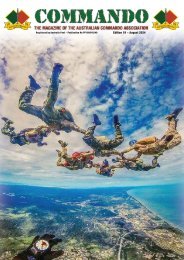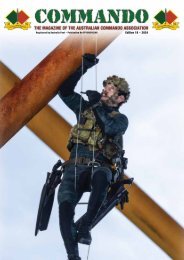Commando News Magazine edition 8 2021
Create successful ePaper yourself
Turn your PDF publications into a flip-book with our unique Google optimized e-Paper software.
without supplies for ten months, subsisting on locally<br />
grown and raised fish, chickens, sweet potatoes and<br />
bananas. The radio was for military use only, and Ruby<br />
received only three personal messages during war,<br />
advising her of the deaths of her father, mother, and<br />
sister. Her activities became known to the Japanese,<br />
who at one point broadcast a message to her in<br />
English: "Calling Mrs Boye, Japanese commander say<br />
you get out!" 3<br />
Vanikoro was completely defenceless, protected<br />
only by its formidable coral reef. Japanese boats<br />
attempted to discover the channel into the harbour<br />
with out success. It was bombed once, and leaflets<br />
were dropped. Skov and Ruby decided to move the<br />
radio station away from their home at Paeu, the main<br />
village on the south-west coast, and into the<br />
mountains. The plan was to escape into the jungle if<br />
the Japanese invaded. In the event, Vanikoro was<br />
never occupied by the Japanese. Unfortunately, the<br />
suspension bridge over the Lawrence River sub -<br />
sequently collapsed, forcing Ruby to make the trip over<br />
its crocodile-infested water in a punt four times a day 4 .<br />
Ruby provided vital information during the Battle of<br />
the Coral Sea in May 1942 and the Battle of the Santa<br />
Cruz Islands in October 1942. After the Japanese<br />
executed an elderly planter as a spy in March 1942, the<br />
Coastwatchers were commissioned as officers in the<br />
RAAF or Royal Australian Navy to provide some legal<br />
protection under the Geneva Conventions, although it<br />
was far from certain that the Japanese would honour it;<br />
but it was not until 27 July 1943 that Ruby was officially<br />
appointed an Honorary Third Officer in the Women's<br />
Royal Australian Naval Service (WRANS) 5 . Her uniform<br />
was later dropped to her by parachute.<br />
Admiral William ‘Bull’ Halsey, Jr, then Commander<br />
of the US Third Fleet paid her a visit, Upon arriving on<br />
the island in a PBY Catalina flying boat to personally<br />
thank her for her services he was reported to have<br />
walked into their home one day and said: “My name’s<br />
Halsey. I just want to meet the marvellous Australian<br />
woman who runs the radio.” He also admitted to<br />
“playing hooky” by visiting 6 . When she became ill with<br />
shingles in late 1943, he arranged for a PBY to fly her<br />
to Australia for hospital treatment, and for four US<br />
Navy sailors to man the radio station until she returned.<br />
After three weeks she resumed her duty. The station<br />
remained operational until she received the news over<br />
her radio in August 1945 that the war had ended, but<br />
she continued sending weather messages for the<br />
3<br />
Djokovic, Petar (2017). "Calling Mrs Boye". Semaphore. Retrieved 17<br />
April 2018.<br />
4<br />
"Ruby Boye-Jones oral history interview". National Museum of the<br />
Pacific War. Retrieved 17 April 2018.<br />
5<br />
"Ruby Boye – Coastwatcher Heroine". Naval Historical Society of<br />
Australia. Retrieved 17 April 2018.<br />
6<br />
"Ruby Boye-Jones oral history interview". National Museum of the<br />
Pacific War. Retrieved 17 April 2018.<br />
Bureau of Meteorology. Her appointment in the<br />
WRANS was terminated on 30 September 1946.<br />
Ruby at her radio on Vanikoro. Source: RAN Historical Society<br />
For her wartime services, Ruby was awarded the<br />
British Empire Medal in 1944,[6] which was presented<br />
to her in a ceremony in Suva in 1946 7 . She also received<br />
the 1939-1945 Star, the Pacific Star, the Australia<br />
Service Medal 1939-1945 and the War Medal 1939-<br />
1945; but no pay, as her rank was, unlike that of her<br />
male counterparts, considered honorary.<br />
The timber industry resumed after the war ended<br />
and in 1947 Skov became seriously ill with leukemia,<br />
and he and Ruby returned to Sydney in August 1947.<br />
He died two weeks later. She later married Frank<br />
Bengough Jones, a departmental manager, at St<br />
John's Anglican Church in Penshurst on 19 June 1950,<br />
but he died in 1961. In later life, now known as Ruby<br />
Boye-Jones, she suffered from diabetes, and had her<br />
left leg amputated below the knee. On the occasion of<br />
her 98 th birthday in 1989, the Chief of Naval Staff, Vice<br />
Admiral Michael Hudson, wrote to her: "Your name is<br />
synonymous with the finest traditions of service to the<br />
Navy and the nation. We have not, nor will not, forget<br />
your wonderful contribution."<br />
Ruby died in Narwee, New South Wales, on 14<br />
September 1990. Her remains were cremated. An<br />
accommodation block at the Australian Defence Force<br />
Academy in Ruby left Vanikoro only when her husband<br />
became seriously ill in 1947. He died shortly after they<br />
arrived in Sydney. On 19 June 1950 she married Frank<br />
Bengough Jones (d.1961), a departmental manager<br />
and widower, at St John’s Church of England,<br />
Penshurst, NSW. Mrs Boye-Jones, as she became<br />
known, remained alone in her Penshurst home after<br />
Frank’s death until she reached her late nineties.<br />
Survived by her two sons of her first marriage, she died<br />
on 14 September 1990 at Narwee, NSW and was<br />
cremated.<br />
7<br />
"Honours and Awards Recommendation – Ruby Olive Boye". Australian<br />
War Memorial. Retrieved 17 April 2018.<br />
COMMANDO ~ The <strong>Magazine</strong> of the Australian <strong>Commando</strong> Association ~ Edition 8 I <strong>2021</strong> 15
















